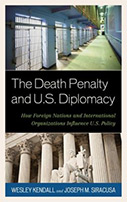The Death Penalty and U.S. Diplomacy: How Foreign Nations and International Organizations Influence U.S. Policy

Authors: Wesley Kendall and Joseph M. Siracusa
Publisher: Lanham, MD: Rowman & Littlefield Publishers, Inc., 2013. 226p.
Reviewer: Nicholas Petersen | March 2014
In this timely text, Kendall and Siracusa showcase the international forces that have and will continue to influence U.S. death penalty policies. Analyzing precedent-setting capital cases, especially those from Texas, the authors argue that, from a diplomatic standpoint, the actions of foreign nations and organizations have made the death penalty an increasingly costly public policy. Chapters 1-2 outline the contours of international law and its influence on the application of capital punishment in America. Next, chapters 3-7 offer a detailed discussion of the various international pressures placed on U.S. criminal justice officials. The concluding section identifies linkages between these diverse forms of international intervention, underscoring their cumulative potential for engendering death penalty abolition.
Drawing from a myriad of sources, including case law, government documents, and original interviews, Kendall and Siracusa investigate the international antecedents of capital punishment abolition in the U.S. The authors employ a comparative case analysis wherein fact-similar cases from Texas and other jurisdictions are contrasted to evaluate the accuracy of their theoretical predictions. Moreover, through data triangulation, they attempt to rule-out alternative explanations for anti-death penalty judicial decisions and governmental actions (e.g., politics, personal preference, precedent, etc.), highlighting the centrality of diplomatic pressures. Although each chapter focuses on a specific type of international intervention, the book is tied together by a common theme: through concerted effort, foreign officials and organizations can limit the number of death sentences rendered in the immediate future and, over time, compel the U.S. to abolish the death penalty.
At its core, the book centers on five distinct, but interrelated, forms of international intervention: publicity, bureaucratic response, application of treaties, litigation, and extradition. Through the use of public awareness campaigns, social justice organizations such as Amnesty International have helped to stay executions, reprieve defendants, and shape death penalty jurisprudence. By invoking the Vienna Convention and disrupting trade negotiations, foreign officials, especially those from Mexico, have altered the U.S.’s death penalty agenda and spared the lives of capital defendants. With the spread of human rights discourses, U.S. death penalty policies have also become increasingly sensitive to decisions issued by international judicial bodies like the International Court of Justice. Furthermore, Mexico’s anti-death penalty stance has forced U.S. officials to forgo capital prosecutions in order to secure the extradition of defendants hiding in Mexico. In part, and taken together, these international interventions have raised the diplomatic costs of capital punishment.
The bookis not without shortcomings, however. The authors focus on Texas because it is the “most prolific executioner” and its abolition would have a “domino effect on other states.” While Texas is the capital of capital punishment, abolition of its death penalty may not produce a “domino effect” as the authors argue. According to Radelet (2009), abolition in “bellwether” states, particularly de facto abolitionist ones like California, could more effectively produce national repeal, and thus the authors should further justify their Texas-based sampling scheme and discuss its implications for the study’s generalizability. Moreover, Kendall and Siracusa’s results are more descriptive than theoretical. Rather than constructing a typology of successful/unsuccessful international interventions that can be used by practitioners and applied to other contexts, they offer a largely descriptive account of the case law. To some extent, these methodological limitations weaken the book’s main arguments.
This book contributes to the capital punishment literature by placing the U.S.’s death penalty within a global context in order to document the international antecedents of contemporary abolition efforts. Given U.S. courts’ growing recognition of human rights discourses, as evidenced by Atkins and Roper, the book offers a much-needed account of the international factors related to recent repeal efforts in several states as well as those poised to produce national abolition. By documenting the failures and successes of various international interventions in limiting the use of American capital punishment this book offers novel insights of interest to social scientists, legal scholars, and activists. In these ways, the authors both broaden and deepen our understanding of America’s death penalty and the international forces that could lead to its demise.
References:
Radelet, M. (2010). The Executioner’s Waning Defenses in Ogletree, C. and A. Sarat (Eds.) The Road to Abolition?: The Future of Capital Punishment in the United States. NYU Press.
Nicholas Petersen, Ph.D. candidate, Department of Criminology, Law & Society, University of California, Irvine


